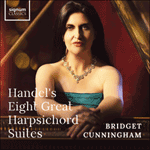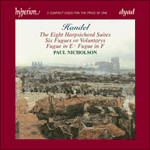Suite No 6 in F sharp minor takes us into a key problematical in Baroque tuning. As the dominant of tragic and suffering B minor, F sharp minor became for Bach a key appropriate to states of ecstasy or pain, while for Couperin it tended to imply sensuous exploration or mystical aspiration. Characteristically, Handel is more down-to-earth, though this suite is among the grandest in the cycle, with a prelude in French dotted rhythm, in four real parts, followed by a massive largo, also in double-dotted rhythm and thick in harmonic texture. The third movement is a spacious fugue making poignant use of suspensions and of sustained cadential pedal notes, while the final gigue, though conventionally frisky in a cross between Italian and French style, preserves a certain grittiness.
from notes by Wilfrid Mellers © 1995
La
Suite no6 en fa dièse mineur, en accords baroques, nous conduit à une problématique se rapportant à la clé. Fa dièse mineur, la dominante du ton tragique et douloureux de si mineur, était pour Bach la clé appropriée aux sentiments d’extase ou de douleur, alors que pour Couperin, elle semblait signifier une exploration sensuelle ou une aspiration mystique. De façon caractéristique, Hændel est plus terre-à-terre, et malgré cela cette œuvre est l’une des Suites les plus grandioses du cycle, avec un Prélude de rythme français pointé à quatre voix, suivi d’un immense largo de texture harmonique dense au rythme aussi doublement pointé. Le troisième mouvement, une longue Fugue, utilise de façon dramatique les suspensions et les notes de pédale de cadence soutenues, alors que la Gigue finale est, de façon conventionnelle, vive et animée, un mélange de styles italien et français qui préserve toutefois une certaine rugosité.
extrait des notes rédigées par Wilfrid Mellers © 1995
Français: Isabelle Dubois
Die
Suite Nr. 6 in fis-moll entführt uns in eine für die barocke Instrumentenstimmung problematische Tonart. Als die Dominante des tragischen und leidenden h-moll wurde fis-moll für Bach eine den Stadien der Ekstase oder des Schmerzes gemäße Tonart, während sie bei Couperin sinnliche Erkundung oder mystisches Streben andeutete. Es ist bezeichnend für Händel, daß er nüchterner ist, doch trotzdem gehört diese Suite zu den größten im Zyklus. Sie besitzt ein Präludium in französischen punktierten Rhythmen und vier richtige Teile, auf die ein gewaltiges Largo folgt, welches gleichfalls doppelt punktierte Rhythmen und eine üppige harmonische Struktur besitzt. Der dritte Satz ist eine weiträumige Fuge, in der scharfsinniger Gebrauch von verzögerten Einsätzen und von angehaltenen Vorhaltspedalnoten gemacht wird. Die Gigue zum Schluß, eine Kreuzung des italienischen und französischen Stils, wirkt dagegen auf konventionelle Art verspielt, wenn ihr auch eine gewisse Forschheit zu eigen ist.
aus dem Begleittext von Wilfrid Mellers © 1995
Deutsch: Angelika Malbert





 Handel: Eight Great Harpsichord Suites
Handel: Eight Great Harpsichord Suites Handel: Harpsichord Suites
Handel: Harpsichord Suites
